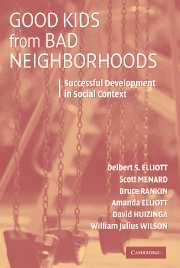Book contents
- Frontmatter
- Contents
- List of Tables and Figures
- Foreword by Richard Jessor
- Acknowledgments
- 1 Growing Up in Disadvantaged Neighborhoods
- 2 Growing Up in Denver and Chicago: The MacArthur Neighborhood Study
- 3 Good and Bad Neighborhoods for Raising Children
- 4 The Effects of Growing Up in a Bad Neighborhood: Initial Findings
- 5 Critical Dimensions of Neighborhood Organization and Culture
- 6 The Effects of Neighborhood Organization and Culture
- 7 Family Influences: Managing Disadvantage and Promoting Success
- 8 School Climate and Types of Peer Groups
- 9 What Matters Most for Successful Youth Development?
- 10 Successful Development in Disadvantaged Neighborhoods
- Appendix A
- Appendix B
- References
- Author Index
- Subject Index
Appendix B
Published online by Cambridge University Press: 06 August 2009
- Frontmatter
- Contents
- List of Tables and Figures
- Foreword by Richard Jessor
- Acknowledgments
- 1 Growing Up in Disadvantaged Neighborhoods
- 2 Growing Up in Denver and Chicago: The MacArthur Neighborhood Study
- 3 Good and Bad Neighborhoods for Raising Children
- 4 The Effects of Growing Up in a Bad Neighborhood: Initial Findings
- 5 Critical Dimensions of Neighborhood Organization and Culture
- 6 The Effects of Neighborhood Organization and Culture
- 7 Family Influences: Managing Disadvantage and Promoting Success
- 8 School Climate and Types of Peer Groups
- 9 What Matters Most for Successful Youth Development?
- 10 Successful Development in Disadvantaged Neighborhoods
- Appendix A
- Appendix B
- References
- Author Index
- Subject Index
Summary
Unstandardized regression coefficients estimate the influence of a predictor on an outcome using whatever units the variables were originally measured in (feet, pounds, inches, number of people, or an arbitrary scale score, for instance). If we denote the unstandardized regression coefficient as b, then a one unit increase in the predictor is associated with a b unit change in the outcome. For example, from Table A8.2, a one unit change in the index of Neighborhood Deterioration is associated with a -.012 unit change in student status, and a one unit change in Neighborhood Bonding/Control is associated with a 0.015 unit change in student status. Because both Neighborhood Deterioration and Neighborhood Bonding/Control are measured as standard deviations (in other words, the standard deviation is the unit of measurement), and because student status is measured as a proportion of respondents in the neighborhood enrolled in school, then a one standard deviation increase in Neighborhood Deterioration is associated with a decrease (because of the negative sign) of .012, or 1.2 percent, in the proportion or percentage, respectively, of respondents who are either enrolled in school or have graduated high school; and a one standard deviation increase in Neighborhood Bonding/Control is associated with an increase (positive coefficient) of .015, or 1.5 percent, in the proportion or percentage of respondents either enrolled in school or graduated from high school.
When both the predictor and the outcome are measured as standard deviations, the resulting coefficient is a standardized coefficient.
- Type
- Chapter
- Information
- Good Kids from Bad NeighborhoodsSuccessful Development in Social Context, pp. 349 - 352Publisher: Cambridge University PressPrint publication year: 2006



